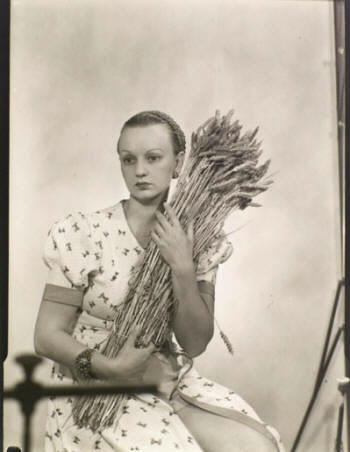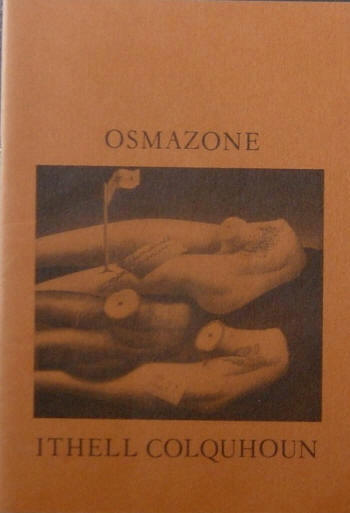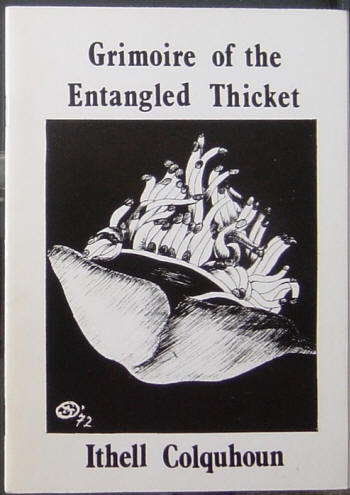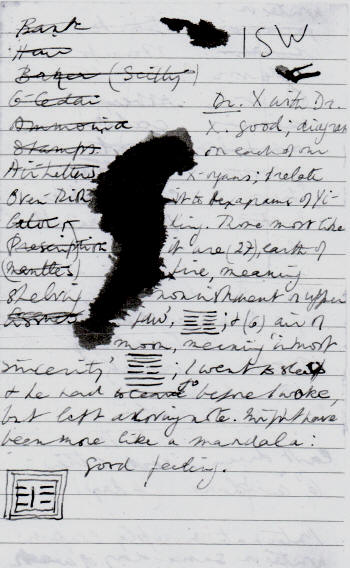|
Medea’s charms: the writings of
Ithell Colquhoun
Ithell Colquhoun (photograph below left by Man Ray) is best known as a
Surrealist artist. Her occult-infused novel, 'I Saw Water', unavailable
during her lifetime, has now been published by Pennsylvania State
University. Richard
Shillitoe who co-edited the text, describes the book and its context.
 Ithell
Colquhoun (1906-1988) was a highly original creative force who expressed
herself through painting, collage, poetry, novels, short stories and
topographical books. This diversity was bound together by an animistic
view of the universe in which, in some mystical sense, all matter is
alive and interconnected. It is a refrain that runs through all her
work, being especially evident in her best known book, The Living
Stones: Cornwall (1958). It is contained within the title itself,
just as it is in the title of her earlier book on Ireland, The Crying
of the Wind (1956). In her world, both literal and metaphorical,
stones live and the wind cries. Ithell
Colquhoun (1906-1988) was a highly original creative force who expressed
herself through painting, collage, poetry, novels, short stories and
topographical books. This diversity was bound together by an animistic
view of the universe in which, in some mystical sense, all matter is
alive and interconnected. It is a refrain that runs through all her
work, being especially evident in her best known book, The Living
Stones: Cornwall (1958). It is contained within the title itself,
just as it is in the title of her earlier book on Ireland, The Crying
of the Wind (1956). In her world, both literal and metaphorical,
stones live and the wind cries.
Colquhoun was drawn to Cornwall as a place where spiritual and earth
forces are constantly revealed through standing stone, holy well and
natural rock formation. She spent much time in trying to engage with
these natural forces through divination, meditation and the study of
occult theory. Her association with the Land’s End Peninsula,
established during childhood holidays, was resumed during frequent trips
to escape from wartime London. In 1949 she purchased a rudimentary
tin-roofed wooden studio in the Lamorna Valley which she named Vow Cave.
This was uninhabitable during winter, but in 1959 she was able to buy
Polgreen Cottage in Paul (later renaming it Stone Cross Cottage) and saw
no need for further relocations. She lived there until her death in
1988. Much of her writing was done in Cornwall and much of it reflects
its ambience. Her literary talents, however, had already been evident
for many years, initially finding expression in the essay format.
 Essays Essays
One constantly present theme in her essays is the magical. It was
displayed in her first publication, The Prose of Alchemy (1930),
a lengthy essay that celebrates the rich poetic imagery found in many of
the classical alchemical texts of previous centuries. It was written
whilst she was a student at the Slade School of Art and published in
G.R.S. Mead’s influential journal of Gnosticism and esotericism, The
Quest. Mead had been part of Helene Blavatsky’s inner circle in the
1880's but he had resigned following internal schisms within the
Theosophical Society and formed the Quest Society. Colquhoun’s essay was
later described by the poet David Gascoyne as “one of the best, most
stimulating, short introductions to the subject of alchemy considered as
imaginative literature that exists in English”.
A later essay The Mantic Stain (1949) was the first article to be
published in English on automatism, the method practiced extensively by
the surrealists (as well as many mediums) for finding inspiration in
apparently random blots, smudges and stains, into which they ‘read’
images or built narratives. In trying to get beyond conscious, rational
control, Colquhoun herself practiced many automatic methods for
generating images or word combinations and associations.
In another essay, The Night Side of Nature (1953), she attempted
to reconcile contemporary science and the apparently discredited old
world-view of the animists and the alchemists. She defended the
so-called pathetic fallacy, proposing that Man is subjected to the same
forces that impel the rest of nature. She drew parallels between human
psychology and natural phenomena, regarding, for example, the
‘splitting’ of the psyche as described by contemporary psychiatrists as
essentially the same process that splits rocks such as shale and slate.
Geoffrey Taylor, the literary editor of The Bell, the foremost Irish
literary periodical of the time, praised the lucidity of her writing and
described the essay as “elegant and ingenious – the most persuasive
account of the new astrology that I’ve seen”.
Other writings on esoteric themes range from the popular to the
recondite. The series of articles written for Prediction magazine were
intended for a general audience, whereas the essay in which she
speculated that women are more evolved than men because their bodies
contain more orifices must have been understood (or taken seriously) by
a much smaller audience!
Poetry and short stories
 Throughout
her life she published poems, short stories and translations of French
poetry in literary magazines. She is well known for her links with the
surrealist group in London just before World War II, but it is rarely
appreciated that for a short period in the 1940s she was also associated
with the New Apocalypse writers. Largely forgotten today, The New
Apocalypse was a post-surrealist Romantic movement whose leading lights,
the poets Henry Treece and Jim Hendry, thought highly of her work,
especially the psychological insights shown in her short stories. They
planned to include her work in Apocalyptic anthologies. However, the war
and personal animosities put paid to their collaborations. In fact this
was Colquhoun’s constant fate; to be on the periphery of groups, seldom
fully accepted, sometimes expelled. Behind great personal charm she had
a steely determination and refusal to compromise that was off-putting to
many. Even today, despite being the most original of the British
surrealists, she has never been properly recognised by art or literary
critics, or by the general public who seldom have the opportunity to
view or read her work. Throughout
her life she published poems, short stories and translations of French
poetry in literary magazines. She is well known for her links with the
surrealist group in London just before World War II, but it is rarely
appreciated that for a short period in the 1940s she was also associated
with the New Apocalypse writers. Largely forgotten today, The New
Apocalypse was a post-surrealist Romantic movement whose leading lights,
the poets Henry Treece and Jim Hendry, thought highly of her work,
especially the psychological insights shown in her short stories. They
planned to include her work in Apocalyptic anthologies. However, the war
and personal animosities put paid to their collaborations. In fact this
was Colquhoun’s constant fate; to be on the periphery of groups, seldom
fully accepted, sometimes expelled. Behind great personal charm she had
a steely determination and refusal to compromise that was off-putting to
many. Even today, despite being the most original of the British
surrealists, she has never been properly recognised by art or literary
critics, or by the general public who seldom have the opportunity to
view or read her work.
Two slender collections of poetry and prose writings were published
during her life: Grimoire of the Entangled Thicket (1973) and
Osmazone ten years later in 1983. Both were illustrated with her own
drawings. The eight poems in the Grimoire owe much to Robert Graves’
theorising about Celtic mythology and the White Goddess. They form part
of a series of twenty two poems – one each for the thirteen month Celtic
lunar calendar plus nine for the pagan festivals that mark the year’s
progression.
Osmazone is a strange but representative compilation that
includes both poems and short prose pieces. There is a poem about the
anus, a short story in which a woman applying for a position in a
modelling agency includes in her CV jobs in which she has modelled for
enemas and gynaecological examinations. A short autobiographical text
deals with her menarche, whilst a ‘found-object poem’ lists varieties of
condoms. There is a surrealist group-poem in which each participant
contributes a line in ignorance of what has gone before, whilst another
poem gives tonsorial advice to a member of a family of Breton
nationalists. It is a shame that it was published in such a small
edition (only 200 copies) and is very hard to find today.
 Other
Writings Other
Writings
In addition to her two published travel books she wrote another, The
Blue Anoubis, based on a Nile journey undertaken in 1966, and also
illustrated with her own drawings. The book is raised above the level of
a travelogue by her regular and detailed comments on Egyptian gods and
godesses: “It is amusing”, she wrote, “to classify the deities of the
pantheon, according to their morphology, under the various zodiacal
signs”, before proceeding to tabulate their attributes. Maybe so, but
this must also have limited its appeal to any prospective publisher.
In 1968 she was asked by the editor to contribute a series of articles
on holiday destinations to The Times Educational Supplement. This she
did with gusto, in one instance offering readers unexpected information
regarding archangels.
Novels
Colquhoun’s first novel was Goose of Hermogenes, published in
1961 but written over twenty years previously. On the surface, it is
about the heroine’s relationship with her uncle who lives on his island
retreat and engages in esoteric experimentation, the ultimate aim of
which is to conquer death. The heroine undergoes trials involving
separation and purification. She discovers the transforming power of
sexual ecstasy. Through physical imprisonment and psychic probing, she
learns about possession, both physical and spiritual. Eventually, she
returns to her point of departure, to the house where her parents had
separated, and achieves reconciliation with her father, now dead.
It is, clearly, an allegory of the alchemists’ quest, whether it be
regarded as the elixir of life or spiritual purification. The context is
not merely alchemical, however, but contains Pagan and orthodox Catholic
strands whilst having much to say about Goddesses and gender
inequalities. Some passages are clearly derived from dreams, but as no
working drafts survive, her method of composition is not recorded. The
position is very different as far as I Saw Water is concerned
because she kept all the drafts and notes.
I Saw Water
It was Colquhoun’s life-long practice to record her night-time dreams.
Dreams were important to her both as a source of artistic inspiration
and of hidden, magical knowledge. During sleep, she would have argued,
rationality is at its weakest. Sleep, therefore, is the time when we are
closest to the gods and at our most receptive to godly messages – if we
can understand them. For her, artistic inspiration and magical knowledge
were one and the same. The illustration, of a notebook page from the
early 1950s (below right), shows just how art, literature, dream and
magic were integral to Colquhoun’s daily life.
 There
is a shopping list on the left of the note, apparently anticipating a
trip to the Scilly Isles. The large ink blot in the middle serves as a
reminder that her visual art relied heavily on the interpretation of
chance forms generated through automatic processes. The dream summary on
the right hand side has been earmarked for possible inclusion in I
Saw Water. (The Dr. X of the dream was a Jungian psychotherapist
which whom Colquhoun, a patient of his for a spell, had a difficult
transference relationship.) The patterns of short horizontal lines form
some of the figures of the Yi-King (more commonly spelled I-Ching)
derived from an ancient method of divination and which Colquhoun
incorporated into the novel. There
is a shopping list on the left of the note, apparently anticipating a
trip to the Scilly Isles. The large ink blot in the middle serves as a
reminder that her visual art relied heavily on the interpretation of
chance forms generated through automatic processes. The dream summary on
the right hand side has been earmarked for possible inclusion in I
Saw Water. (The Dr. X of the dream was a Jungian psychotherapist
which whom Colquhoun, a patient of his for a spell, had a difficult
transference relationship.) The patterns of short horizontal lines form
some of the figures of the Yi-King (more commonly spelled I-Ching)
derived from an ancient method of divination and which Colquhoun
incorporated into the novel.
In about 1967 she began trawling through her dream diaries of the
previous two decades, selecting those that she felt were linked in some
way. She stitched them together, gave them a setting and a narrative
structure, and the result was I Saw Water.
It is set on the island of Ménec where Sister Brigid is a nun. The Order
she belongs to, the Sisters of the Parthenogenesis, is ostensibly Roman
Catholic, but its mission is more reminiscent of certain schools of
alchemy than of Catholicism: it is the unification of the separated
genders. The achievement of this will transmute fallen, sinful, humanity
to a state of spiritual perfection, restore nature’s equilibrium and
confirm the unity of the hermetic cosmos. In addition, many aspects of
conventual and ritual life on Ménec have more in common with Pagan
nature worship than with Christianity. Colquhoun also drew on her
knowledge as a practicing Druid. Ménec itself, it transpires, is the
Island of the Dead and all the inhabitants, nuns and laity alike, are in
transit, working their way towards their second death. The second death
is a teaching that is not found in Judeo-Christian theology but is
associated with Eastern belief systems. Colquhoun would have been
familiar with it through her membership of the Theosophical Society. A
major influence on Sister Brigid is the local landowner, a figure who is
surely to be identified with Adonis, the mythological vegetation god. He
entices Brigid from the convent, but dies (inevitably) by drowning.
Eventually, Brigid is able to cast off her personality and human
emotions and achieves a state of disembodied peace. The book is narrated
in a matter-of-fact style that recounts as commonplace a remarkable
series of events. Naturalistic passages are juxtaposed with lengthy
sequences, almost unaltered from the dream diaries, with resulting
dislocations of time, place and logic.
I Saw Water is published in a volume that includes an
introduction and end notes. It is supplemented with a full bibliography,
a number of poems, short texts and images, many also printed for the
first time, which place the novel in the broader context of Colquhoun’s
work. It is not light holiday reading and you will not find it at the
railway station bookstore or the airport news-stand. But, if you are at
all interested, seek it out. It is the first substantive piece of
Colquhoun’s writing to appear since her death. It will transform your
understanding of her and her life’s work.
publisher’s web site
http://www.psupress.org/books/titles/978-0-271-06423-9.html
see also
http://www.ithellcolquhoun.co.uk/ |


